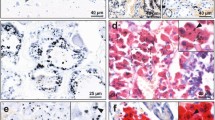Abstract
Mercury levels measured in urine, hair, and saliva of 245 German children (8–10 years old) are reported. Mercury concentrations in urine ranged between <0.1 and 5.3 μg/l [geometric mean (GM) 0.26 μg/l or 0.25 μg/g creatinine; median for both, 0.22 in μg/l and μg/g, respectively]. Using multiple linear regression analysis, two predictors have been found accounting for 25.3% of the variance of mercury levels in urine: the number of teeth with amalgam fillings (23.2%) and the number of defective amalgam fillings (2.1%). The mercury content in hair ranged from <0.06 to 1.7 μg/g (GM 0.18 μg/g; median 0.18 μg/g). The frequency of fish consumption, the smoking habits of the parents, and the age of the children accounted for 20.4% of the variance of mercury levels in hair. The correlation between the hair mercury content and urine mercury concentration was low (r=0.297). Mercury levels in saliva ranged between <0.32 and 4.5 μg/l (median 0.16 μg/l). The mercury concentration in saliva was below the limit of quantification of 0.32 μg/l in more than 70% of the samples. Mercury analysis in urine is suitable to estimate mercury exposure due to amalgam fillings, whereas hair mercury better reflects mercury intake by fish consumption. Up to now, saliva does not seem to be a suitable tool to monitor the mercury burden, at least not at low exposure levels.
This is a preview of subscription content, access via your institution
Access options
Subscribe to this journal
Receive 6 print issues and online access
$259.00 per year
only $43.17 per issue
Buy this article
- Purchase on Springer Link
- Instant access to full article PDF
Prices may be subject to local taxes which are calculated during checkout








Similar content being viewed by others
References
Batista J Schuhmacher M Domingo JL Corbella J Mercury in hair for a child population from Tarragona Province, Spain, Sci Total Environ (1996) 193: 143–148
Becker K Kaus S Krause C Lepom P Schulz C Seiwert M Seifert B German Environmental Survey 1998 (GerEs III): environmental pollutants in blood of the German population, Int J Hyg Environ Health (2002a) 205 4(in press)
Becker K Schulz C Kaus S Seiwert M Seifert B German Environmental Survey 1998 (GerEs III): environmental pollutants inurine of the German population, Int J Hyg Environ Health (2002b) (in press)
Becker K Seiwert M Bernigau W Hoffmann K Krause C Nöllke P Schulz C Schwabe R Umwelt-Survey 1990/92, Quecksilber-Zusammenhangsanalyse. vol. VII WaBoLu-Hefte 6/96 Umweltbundesamt, Berlin, Germany 1997
Begerow J Zander D Freier I Dunemann L Long-term mercury excretion in urine after removal of amalgam fillings, Int Arch Occup Environ Health (1994) 66: 209–212
Björkman L Sandborgh-Englund G Ekstrand J Mercury in saliva and feces after removal of amalgam fillings, Toxicol Appl Pharmacol (1997) 144: 156–162
Center of Disease Control and Prevention (CDC) Blood and hair mercury levels in young children and women of childbearing age—United States, 1999, JAMA, J Am Med Assoc (2001) 285(11): 1436–1437
Echeverria D Vasken Aposhian H Woods JS Heyer NJ Aposhian MM Bittner AC Jr Mahurin RK Cianciola M Neurobehavioral effects from exposure to dental amalgam Hg°: new distinctions between recent exposure and Hg body burden, FASEB J (1998) 12: 971–980
Eneström S Hultman P Does amalgam effect the immune system? A controversial issue, Int Arch Allergy Immunol (1995) 106: 180–203
Ewers U Krause C Schulz C Wilhelm M Reference values and human biological monitoring values for environmental toxins, Int Arch Occup Environ Health (1999) 72: 255–260
Ganss C Gottwald B Traenckner I Kupfer J Eis D Mönch J Gieler U Klimek J Relation between mercury concentrations in saliva, blood, and urine in subjects with amalgam restorations, Clin Oral Invest (2000) 4: 206–211
Grandjean P Weihe P White RF Debes F Araki S Yokoyama K Murata K Sorensen N Dahl R Jorgensen PJ Cognitive deficit in 7-year-old children with prenatal exposure to methylmercury, Neurotoxicol Teratol (1997) 19(6): 417–428
Harhammer R Zur Risikobewertung des zahnärztlichen Füllungswerkstoffes Amalgam, Bundesgesundheitsbl-Gesundheitsforsch-Gesundheitsschutz (2001) 44: 149–154 in German
Herber RFM de Gree AJ Wibowo AAE Exposure of dentists and assistants to mercury: mercury levels in urine and hair related to conditions of practice, Commun Dent Oral Epidemiol (1988) 16: 153–158
Krämer U Koch T Ranft U Ring J Behrendt H Traffic-related air pollution is associated with atopy in children living in urban areas, Epidemiology (2000) 11: 64–70
Lygre GB Hol PJ Eide R Isrenn R Gjerdet NR Mercury and silver in saliva from subjects with symptoms self-related to amalgam fillings, Clin Oral Invest (1999) 3: 216–218
Olstad ML Holland RI Wandel N Petersen A Correlation between amalgam restorations and mercury concentrations in urine, J Dent Res (1987) 66: 1179–1182
Ott KHR Die Messung der Quecksilberbelastung im Speichel, Dtsch Zahna¨rztl Z (1993) 48: 154–157
Pellizzari ED Fernando R Cramer GM Meaburn GM Bangerter K Analyses of mercury in hair of EPA Region V population, J Expos Anal Environ Epidemiol (1999) 9(5): 393–401
Sällsten G Thorén J Barregard L Schütz A Skarping G Long-term use of nicotine chewing gum and mercury exposure from dental amalgam fillings, J Dent Res (1996) 75: 594–598
Schierling P Schaller KH Einfache und zuverlässige Methoden zur atomabsorptionsspektrometrischen Bestimmung von Quecksilber in Blut und Urin, Zeitschr für Praxis, Klinik, Forschung und Begutachtung (1981) 3: 57–61
Schulte A Stoll R Wittich M Pieper K Stachniss V Quecksilberkonzentration im Urin von Kindern mit und ohne Amalgamfüllungen, Schweiz Monatsschr Zahnmed (1994) 104: 1336–1340
Schweinsberg F Kroiher A Quecksilberbelastung durch Fischkonsum bei Rheinfischern, Zbl Hyg (1994) 195: 529–543 in German
Seifert B Becker K Helm D Krause C Schulz C Seiwert M The German Environmental Survey 1990/92 (GerES II): reference concentrations of selected environmental pollutants in blood, urine, hair, house dust, drinking water and indoor air, J Expos Anal Environ Epidemiol (2000) 10: 552–565
Silbergeld EK New approaches to monitoring environmental neurotoxins In: Malamud D., and Tabak L. (Eds.) Saliva as a Diagnostic Fluid Ann NY Acad Sci (1993) 694: 62–71
Soleo L Elia G Apostoli P Vimercati L Pesola G Gagliardi T Schiavulli N Drago I Lasorsa G Russo A The influence of amalgam fillings on urinary mercury excretion in subjects from Apulia, G Ital Med Lav (1998) 20(2): 75–81
Trepka MJ Heinrich J Krause C Schulz C Wist M Popescu M Wichmann H-E Factors affecting internal mercury burdens among eastern German children, Arch Environ Health (1997) 52(2): 134–138
Vondenhof T Beindorf H Beschreibung eines Infrarotstrahlers aus Quarzglas zur Bestimmung von Quecksilber in Wasser und Lebensmitteln, Dtsch Lebensm-Umsch (1976) 5: 158–159
Walkowiak J Altmann L Krämer U Sveinsson K Turfeld M Weishoff-Houben M Winneke G Cognitive and sensorimotor functions in 6-year-old children in relation to lead and mercury levels: adjustment for intelligence and contrast sensitivity in computerized testing, Neurotoxicol Teratol (1998) 20: 511–521
WHO Environmental Health Criteria 101, Methylmercury. Geneva, Switzerland 1990 pp 24–37
WHO Environmental Health Criteria 118, Inorganic Mercury. Geneva, Switzerland 1991 pp 29–34
Wilhelm M Idel H Hair analysis in environmental medicine, Zbl Hyg (1996) 198: 485–501
Wilhelm M Lombeck I Kouros B Wuthe J Ohnesorge FK Duplikatstudie zur Aufnahme von einigen Metallen/Metalloiden bei Kindern in Deutschland: Teil I. Arsen und Quecksilber, Zbl Hyg (1995) 197: 345–356
Wilhelm M Müller F Idel H Biological monitoring of mercury vapour exposure by scalp hair analysis in comparison to blood and urine, Toxicol Lett (1996) 88: 221–226
Wilhelm M Pesch A Rostek U Begerow J Schmitz N Idel I Ranft U Concentrations of lead in blood, hair and saliva of German children living in three different areas of traffic density, Sci Total Environ (2002) (in press)
Acknowledgements
The authors thank Dr. L. Lajoie-Junge for final linguistic manuscript check.
Author information
Authors and Affiliations
Corresponding author
Rights and permissions
About this article
Cite this article
PESCH, A., WILHELM, M., ROSTEK, U. et al. Mercury concentrations in urine, scalp hair, and saliva in children from Germany. J Expo Sci Environ Epidemiol 12, 252–258 (2002). https://doi.org/10.1038/sj.jea.7500228
Received:
Published:
Issue Date:
DOI: https://doi.org/10.1038/sj.jea.7500228
Keywords
This article is cited by
-
Mercury Concentration in Saliva and the Impact of Chewing: An Inductively Coupled Plasma Mass Spectrometry Study
Biological Trace Element Research (2023)
-
Assessment of surface water quality and mercury levels from Artisanal and small-scale gold mining (ASGM) along Acupan River, Benguet, Philippines
Environmental Geochemistry and Health (2022)
-
Children’s Hair Mercury Concentrations and Seafood Consumption in Five Regions of Japan
Archives of Environmental Contamination and Toxicology (2018)
-
Evaluating the effect of age and area of residence in the metal and metalloid contents in human hair and urban topsoils
Environmental Science and Pollution Research (2016)
-
The extent of mercury (Hg) exposure among Saudi mothers and their respective infants
Environmental Monitoring and Assessment (2015)



